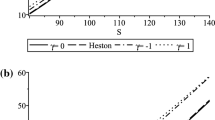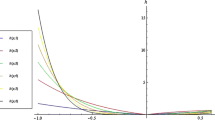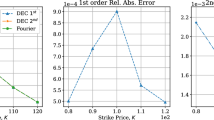Abstract
Compound options are not only sensitive to future movements of the underlying asset price, but also to future changes in volatility levels. Because the Black–Scholes analytical valuation formula for compound options is not able to incorporate the sensitivity to volatility, the aim of this paper is to develop a numerical pricing procedure for this type of option in stochastic volatility models, specifically focusing on the model of Heston. For this, the compound option value is represented as the difference of its exercise probabilities, which depend on three random variables through a complex functional form. Then the joint distribution of these random variables is uniquely determined by their characteristic function and therefore the probabilities can each be expressed as a multiple inverse Fourier transform. Solving the inverse Fourier transform with respect to volatility, we can reduce the pricing problem from three to two dimensions. This reduced dimensionality simplifies the application of the fast Fourier transform (FFT) method developed by Dempster and Hong when transferred to our stochastic volatility framework. After combining their approach with a new extension of the fractional FFT technique for option pricing to the two-dimensional case, it is possible to obtain good approximations to the exercise probabilities. The resulting upper and lower bounds are then compared with other numerical methods such as Monte Carlo simulations and show promising results.
Similar content being viewed by others
References
Abramowitz, M., & Stegun, I. A. (1965). Handbook of mathematical functions (pp. 389–404). National Bureau of Standards, Applied Math. Series 55, Dover Publications.
Bailey D., Swarztrauber P. (1991) The fractional Fourier transform and applications. SIAM Review, 33(3): 1–18
Barashenkov, I. V., & Oxtoby, O. F. (2007). Moving solitons in the discrete nonlinear Schroedinger equation. Physical Review, E 76.
Brenner M., Ou E.Y., Zhang J.E. (2006) Hedging volatility risk. The Journal of Banking and Finance, 30: 811–821
Carr P. (1988) The valuation of sequential exchange opportunities. Journal of Finance 43: 1235–1256
Carr P., Madan D. (1999) Option valuation using the fast Fourier transform. Journal of Computational Finance, 2(4): 61–73
Chiarella, C., Ziogas, A., & Ziveyi, J. (2010). Representation of American option prices under Heston stochastic volatility dynamics using integral transforms. In Contemporary quantitative finance. New York: Springer.
Chiarella, C., & Kang, B. (2011). The evaluation of American compound option prices under stochastic volatility and stochastic interest rates. Journal of Computational Finance (To appear).
Chourdakis K. (2005) Option pricing using the fractional FFT. Journal of Computational Finance, 8(2): 1–18
Cont, R., & Tankov, P. (2004). Financial modelling with jump processes. Chapman & Hall/CRC Financial Mathematics Series.
Dempster, M., & Hong, S. (2000). Spread option valuation and the fast Fourier transform. In H. Geman, D. Madan, & S. R. Pliska (Eds.) Proceedings of the 1st world congress of the Bachelier Finance Society (pp. 203–220). Berlin: Springer.
Geske R. (1979) The valuation of compound options. Journal of Financial Economics 7: 63–81
Geske R., Johnson H. E. (1984) The American put option valued analytically. The Journal of Finance 39: 1511–1524
Griebsch S., Wystup U. (2011) On the valuation of fader and discrete barrier options in Heston’s stochastic volatility model. Quantitative Finance, 11(5): 693–709
Gukhal C. R. (2003) The compound option approach to American options on jump-diffusions. Journal of Economic Dynamics and Control 28: 2055–2074
Heston S. L. (1993) A closed-form solution for options with stochastic volatility with applications to bond and currency options. Review of Financial Studies 6: 327–343
Lee R. (2004) Option pricing by transform methods: Extensions, unification, and error control. Journal of Computational Finance, 7(3): 51–86
Lipton A. (2001) Mathematical methods for foreign exchange. World Scientific, Singapore
Romberg, J. (2006). Circular convolution and the DFT. http://cnx.org/content/m10786/2.6/.
Schilling H. (2002) Foreign exchange risk, Chap.9. Risk Publications, London
Shephard N.G. (1991) From characteristic function to distribution function: A simple framework for the theory. Econometric Theory, 7(4): 519–529
Zhylyevskyy O. (2010) A fast Fourier transform technique for pricing American options under stochastic volatility. Review of Derivatives Research, 13(1): 1–24
Author information
Authors and Affiliations
Corresponding author
Rights and permissions
About this article
Cite this article
Griebsch, S.A. The evaluation of European compound option prices under stochastic volatility using Fourier transform techniques. Rev Deriv Res 16, 135–165 (2013). https://doi.org/10.1007/s11147-012-9083-z
Published:
Issue Date:
DOI: https://doi.org/10.1007/s11147-012-9083-z




